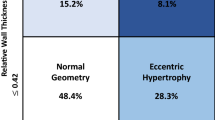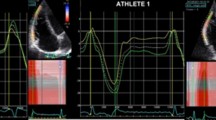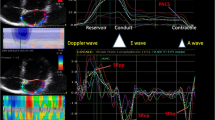Abstract
Objectives: This study sought to investigate the development of left ventricular remodeling during active cycling. Methods: A group of 17-year-old (±0.2 years) highly trained competitive cyclists (group I, n = 66) and a group of 29-year old (± 2.6 years) professional cyclists (group II, n = 35) underwent two-dimensional (2D) echocardiography. Data from groups I and II were compared with values of normal untrained subjects based on the literature. Results: Left atrial dimensions were significantly increased in group II as compared to group I (44 ± 5 vs. 36 ± 4 mm, p < 0.005). Left ventricular end diastolic diameter was significantly increased in group II as compared to group I (61 ± 5 vs. 54 ± 6 mm, p < 0.005). Left ventricular mass was also significantly increased in group II as compared to group I (321 ± 77 vs. 246 ± 59 g, p < 0.005). Wall stress showed a significant inverse relation: 104 ± 42 mmHg in group I vs. 83 ± 14 mmHg in group II (p < 0.005). The early filling phase of the left ventricular inflow was significantly larger in both athlete groups in relation to the normal value. The E-wave in the athletes compared to the E-wave in normal subjects was 0.87 ± 0.17 vs. 0.71 ± 0.14 m/s in group I, p < 0.005, 0.82 ± 0.17 vs. 0.71 ± 0.14 m/s in group II, p < 0.05. Late filling phase and the ratio of the diastolic filling pattern did not show significant differences between the two groups. Conclusions: Left atrial and left ventricular remodeling starts early in the athlete's career. Athletes of 17 years of age already show significant left atrial and left ventricular dilatation compared to data of untrained subjects described in literature. The process of dilatation continues during the athlete's career. Also left ventricular mass is increased at a young age which continues for several years. More than 60% of the athletes in both groups demonstrated an intermediate form of left ventricular hypertrophy. Diastolic function of the left ventricle remains normal during a long period of athletic career performance.
Similar content being viewed by others
References
Pluim BM, Zwinderman AH, van der Laarse A, van der Wall EE. The athlete's heart. A meta-analysis of cardiac structure and function. Circulation 1999; 100: 336–344.
Schairer J, Stein P, Keteyian S, Fedel F, Ehrman J, Alam M. Left ventricular response to submaximal exercise in endurance-trained athletes and sedentary adults. Am J Cardiol 1992; 70: 930–933.
Fagard R, Aubert A, Staessen J, van den Eynde E, van Hees L, Amery A. Cardiac structure and function in cyclists and runners. Comparative echocardiographic study. Br Heart J 1984; 52: 124–129.
Pellicia A, Maron B, Spataro A, Proschan M, Spirito P. The upper limit of physiologic cardiac hypertrophy in highly trained elite athletes. N Engl J Med 1994; 324: 295–301.
Douglas P, O'Toole M, Douglas W, Hiller B, Reichek N. Left ventricular structure and function by echocardiography in ultra endurance athletes. Am J Cardiol 1986; 58: 805–809.
Nishimura T, Yamada Y, Kawai C. Echocardiographic evaluation of long-term effects of exercise on left ventricular hypertrophy and function in professional bicyclists. Circulation 1980; 61: 832–840.
Colan S, Sanders S, Borow K. Physiologic hypertrophy: effects on left ventricular systolic mechanics in athletes. J Am Coll Cardiol 1987; 9: 776–783.
Du Bois D, du Bois EF. Measurement of surface area in man. Arch Int Med 1915; 15: 868–881.
Verdecchia P, Schillaci G, Borgioni G, et al. Adverse prognostic significance on concentric remodeling of the left ventricle in hypertensive subjects with normal left ventricular mass. J Am Coll Cardiol 1995; 25: 871–878.
Krumholz HM, Larson M, Levy D. Prognosis of left ventricular geometric patterns in Framinham Heart Study. J Am Coll Cardiol 1995; 25: 879–884.
Douglas PS, Reichek N, Hackney K, Ioli A, Sutton MG. Contribution of after load, hypertrophy and geometry to left ventricular ejection fraction in aortic valve stenosis, pure aortic regurgitation and idiopathic dilated cardiomyopathy. Am J Cardiol 1987; 59: 1398–1404.
Douglas P, O'Toole M, Katz S, Ginsburg G, Douglas W, Laird R. Left ventricular hypertrophy in athletes. Am J Cardiol 1997; 80: 1384–1388.
Pluim BM. The athletes heart A physiological or a pathological phenomenon? Thesis. ISBN 90–9011769–5.
Pluim BM, Beyerbacht HP, Chin JC, Zwinderman AH, van der Laarse A, van der Wall EE. Comparison of echocardiography with magnetic resonance imaging in the assessment of the athlete's heart. Eur Heart J 1997; 18: 1505–1513.
Rowland T, Unnithan V, Fernhall B, Baynard T, Lange C. Left ventricular response to dynamic exercise in young cyclists. Med Sci Sports Exerc 2002; 34: 637–642.
Feigenbaum H. Echocardiography. 5th ed. Lea & Febinger, 1994; 658–659.
Benjamin EJ, Levy D, Anderson KM, et al. Determinants of Doppler indexes of left ventricular diastolic function in normal subjects. Framingham Heart Study. Am J Cardiol 1992; 70: 508–515.
Reichek N, Wilson J, St John Sutton, Plappert T, Goldberg S, Hirshfeld S. Noninvasive determination of left ventricular end-systolic stress; validation of the method and initial application. Circulation 1982; 65: 99–108.
Devereux RB, Alonso D, Lutas E, et al. Echocardiographic assessment of left ventricular hypertrophy: comparison to necropsy findings. Am J Cardiol 1986; 57: 450–458.
Devereux RB, Reichek N. Echocardiographic determination of left ventricular mass in man. Circulation 1977; 55: 613–618.
Douglas C, Montgomery G. Applied Statistics and Probability for Engineers. John Wiley New York, 1999.
Manolas VM, Pavlik G, Banhegyi A, Faludi J, Sido Z, Olexo Z. Echocardiographic changes in the development of the athlete's heart in 9 to 20–year-old male subjects. Acta Physiol Hung 2001; 88: 259–270.
Hees PS, Fleg JL, Lakatta EG, Shapiro EP. Left ventricular remodeling with age in normal men versus women. Novel insights using three-dimensional magnetic resonance imaging. Am J Cardiol 2002; 90: 1231–1236.
Appleton CM, Hatle L. The natural history of left ventricular filling abnormalities: assessment by two-dimensional and Doppler echocardiography. Echocardiography 1992; 9: 437–457.
Harrison MR, Clifton GD, Pennell AT, DeMaria AN. Effect of heart rate on left ventricular diastolic transmitral flow velocity patterns assessed by Doppler echocardiography in normal subjects. Am J Cardiol 1991; 67: 622–627.
Nagueh SF, Middleton KJ, Kopelen HA, Zoghbi WA, Quinones MA. Doppler tissue imaging: a noninvasive technique for evaluation of left ventricular relaxation and estimation of filling pressures. J Am Coll Cardiol 1997; 30: 1527–1533.
Levine B, Lane L, Buckey J, Friedman D, Blomqvist G. Left ventricular pressure volume and Frank-Starling relations in endurance athletes. Circulation 1991; 84: 1016–1023.
Nidorf SM, Picard MH, Triulizi MO, et al. New perspectives in the assessment of cardiac chamber dimensions during development and adulthood. J Am Coll Cardiol 1992; 19: 983–988.
Author information
Authors and Affiliations
Rights and permissions
About this article
Cite this article
Hoogsteen, J., Hoogeveen, A., Schaffers, H. et al. Left atrial and ventricular dimensions in highly trained cyclists. Int J Cardiovasc Imaging 19, 211–217 (2003). https://doi.org/10.1023/A:1023684430671
Issue Date:
DOI: https://doi.org/10.1023/A:1023684430671




